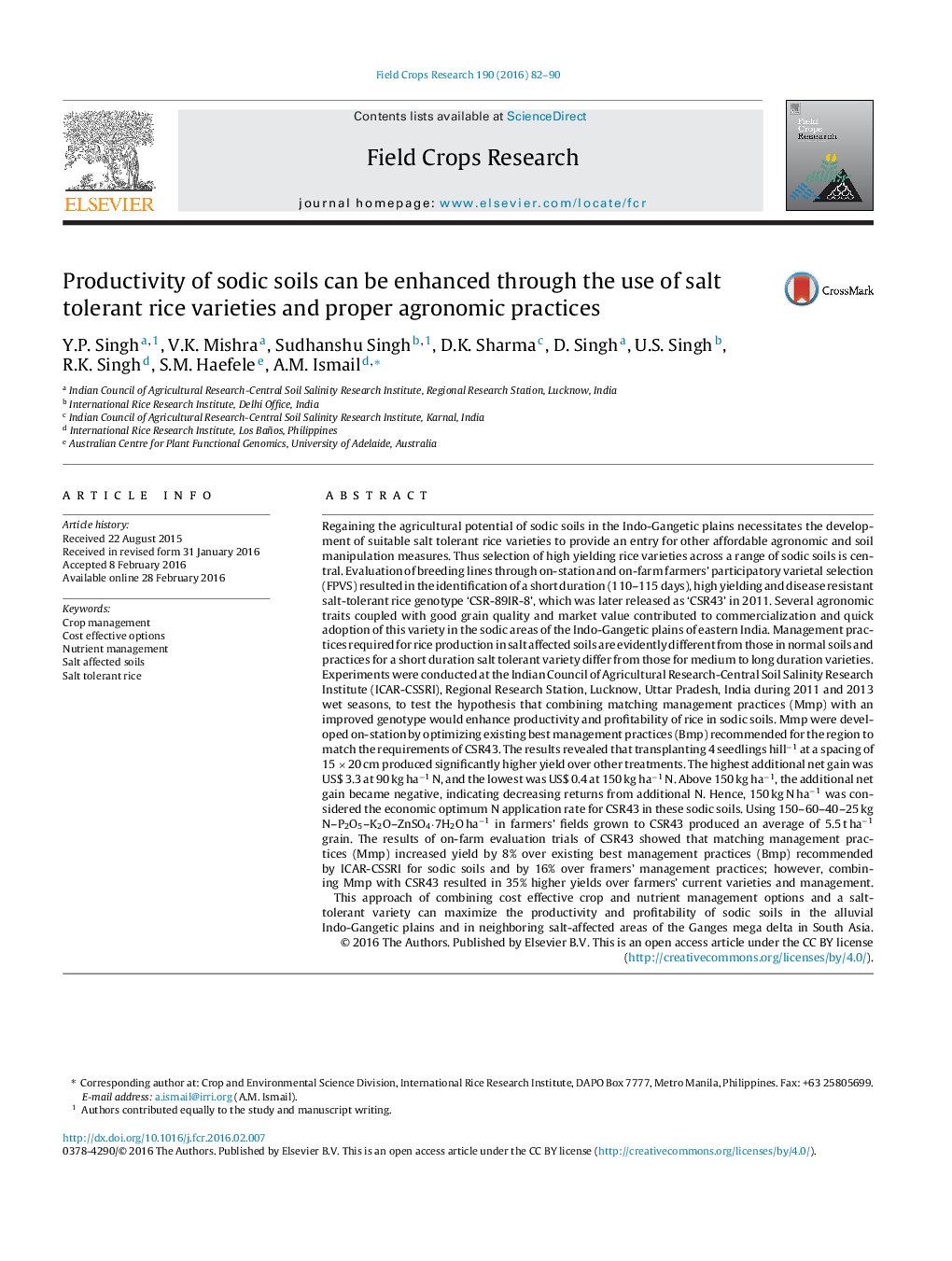| کد مقاله | کد نشریه | سال انتشار | مقاله انگلیسی | نسخه تمام متن |
|---|---|---|---|---|
| 6374473 | 1624673 | 2016 | 9 صفحه PDF | دانلود رایگان |
عنوان انگلیسی مقاله ISI
Productivity of sodic soils can be enhanced through the use of salt tolerant rice varieties and proper agronomic practices
ترجمه فارسی عنوان
بهره وری خاک های سودا را می توان با استفاده از انواع مختلف برنج مقاوم در برابر شور و اقدامات زراعی مناسب افزایش داد
دانلود مقاله + سفارش ترجمه
دانلود مقاله ISI انگلیسی
رایگان برای ایرانیان
کلمات کلیدی
مدیریت محصول، گزینه های موثر مدیریت مواد مغذی، نمک در معرض خاک، برنج تحمل نمک،
موضوعات مرتبط
علوم زیستی و بیوفناوری
علوم کشاورزی و بیولوژیک
علوم زراعت و اصلاح نباتات
چکیده انگلیسی
Regaining the agricultural potential of sodic soils in the Indo-Gangetic plains necessitates the development of suitable salt tolerant rice varieties to provide an entry for other affordable agronomic and soil manipulation measures. Thus selection of high yielding rice varieties across a range of sodic soils is central. Evaluation of breeding lines through on-station and on-farm farmers' participatory varietal selection (FPVS) resulted in the identification of a short duration (110-115 days), high yielding and disease resistant salt-tolerant rice genotype 'CSR-89IR-8', which was later released as 'CSR43' in 2011. Several agronomic traits coupled with good grain quality and market value contributed to commercialization and quick adoption of this variety in the sodic areas of the Indo-Gangetic plains of eastern India. Management practices required for rice production in salt affected soils are evidently different from those in normal soils and practices for a short duration salt tolerant variety differ from those for medium to long duration varieties. Experiments were conducted at the Indian Council of Agricultural Research-Central Soil Salinity Research Institute (ICAR-CSSRI), Regional Research Station, Lucknow, Uttar Pradesh, India during 2011 and 2013 wet seasons, to test the hypothesis that combining matching management practices (Mmp) with an improved genotype would enhance productivity and profitability of rice in sodic soils. Mmp were developed on-station by optimizing existing best management practices (Bmp) recommended for the region to match the requirements of CSR43. The results revealed that transplanting 4 seedlings hillâ1 at a spacing of 15 Ã 20 cm produced significantly higher yield over other treatments. The highest additional net gain was US$ 3.3 at 90 kg haâ1 N, and the lowest was US$ 0.4 at 150 kg haâ1 N. Above 150 kg haâ1, the additional net gain became negative, indicating decreasing returns from additional N. Hence, 150 kg N haâ1 was considered the economic optimum N application rate for CSR43 in these sodic soils. Using 150-60-40-25 kg N-P2O5-K2O-ZnSO4·7H2O haâ1 in farmers' fields grown to CSR43 produced an average of 5.5 t haâ1 grain. The results of on-farm evaluation trials of CSR43 showed that matching management practices (Mmp) increased yield by 8% over existing best management practices (Bmp) recommended by ICAR-CSSRI for sodic soils and by 16% over framers' management practices; however, combining Mmp with CSR43 resulted in 35% higher yields over farmers' current varieties and management. This approach of combining cost effective crop and nutrient management options and a salt-tolerant variety can maximize the productivity and profitability of sodic soils in the alluvial Indo-Gangetic plains and in neighboring salt-affected areas of the Ganges mega delta in South Asia.
ناشر
Database: Elsevier - ScienceDirect (ساینس دایرکت)
Journal: Field Crops Research - Volume 190, April 2016, Pages 82-90
Journal: Field Crops Research - Volume 190, April 2016, Pages 82-90
نویسندگان
Y.P. Singh, V.K. Mishra, Sudhanshu Singh, D.K. Sharma, D. Singh, U.S. Singh, R.K. Singh, S.M. Haefele, A.M. Ismail,
